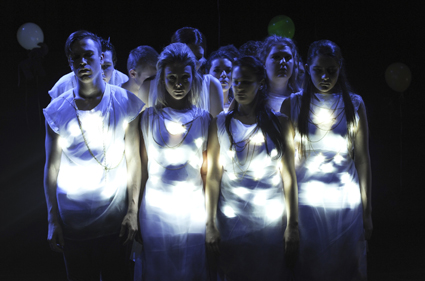Making it
Keith Gallasch: Interview, Peta Downes, Dramatic Arts, AIM

AIM Dramatic Arts, Physical Stages, Lock & Key, 2013
photo Heidrun Löhr
AIM Dramatic Arts, Physical Stages, Lock & Key, 2013
Just across Pitt Street from the RealTime office can be heard sounds of harmony and conflict issuing from the Pilgrim Building (home to the Pilgrim Theatre), where drama students are in training at the Dramatic Arts school. It’s a nice change from screams, curses, car horns and abuse, if sometimes alarming when collective passions are riotously released.
Theatre director Peta Downes, who has performed with Brisbane’s Zen Zen Zo and trained with Anne Bogart, is the new Head of Dramatic Arts (formerly AADA) at the Australian Institute of Music (AIM). She has a vision for greatly enhancing her students’ creativity. “We aim to equip our students with the ability to write a first draft, go to a dramaturg or develop an idea on the floor and get a writer in, as well as being able to work out the finances and use crowd funding. We want them to be employed, and we have a very good track record there, but if not then to create their own work.”
Consequently, Downes sees collaboration as central to actor training. In the concentrated three-years-in-two degree course, teamwork extends to direct engagement with lighting and set design and hands-on backstage experience, with first year students “working on second year productions and learning how to be part of a team.” As well as addressing acting fundamentals, creativity and collaboration, first years engage in scene work and, in the Physical Stages unit, with a physical theatre director.
In the second year “students perform a classic text, construct one of their own in the New Short Works program and work on a ‘given’ text which they produce as well as act in. They will have done Contextual Studies looking at mythology, archetypes and storytelling and will draw on this with the works they’re creating.” A professional director, “probing the world the students are creating,” also works with a student director and dramaturg in each case. Dramaturgy students adapt and correlate material and score physical theatre scripts.
Interestingly none of the current new short works, which have to be imagined, pitched, worked on the floor and scripted with the guidance of director and dramaturg Margaret Davis, is conventional. They are a reworking of the Trials of Azdac in Brecht’s The Caucasian Chalk Circle, and Akio, aimed at a younger audience: “a response to the work of Suzuki Tadashi that also engages with anime as well as with traditional Japanese culture in the form of Kabuki and Noh.” A third short work “responds to Virginia Woolf’s A Room of One’s Own and Orlando as an exploration of the writer’s mind before she decided to end her life.” Downes is emphatic, “Devising is integral to the course.”
Downes describes the two-year Bachelor of Performance course as “vocational, striking a balance between practice and theory and with a practical outcome at the end of each of the six semesters and we seriously address audience development, finances and marketing.”
Many Dramatic Arts graduates have found employment as actors, says Downes, while others have created their own opportunities. She singles out a recent example, Danielle Maas, who with Joseph Kernahan, devised, produced and performed a critically lauded verbatim theatre work, Say Hello First, at Sydney’s Old Fitzroy in July, evidence that the diversity of Dramatic Arts’ approach and its emphasis on building a sense of independence bears fruit.
AIM, Dramatic Arts, http://www.aim.edu.au
RealTime issue #117 Oct-Nov 2013 pg. 31






